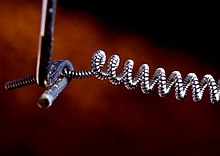Filament

An incandescent filament , also filament or filament , is a coiled wire made of tungsten or tungsten alloys, which converts an electrical current into radiation and thermal energy through its resistance . In contrast to the heating coil , a filament is operated at higher temperatures , so that a higher proportion (approx. 3–15%) of the radiation is emitted as visible light . The physical basis for improving the light yield through an incandescent filament is based on the Langmuir layer around the filament.
The picture shows the filament as a double filament in an incandescent lamp for mains voltage with reduced voltage. The heat losses on the supply wire and - significantly less - on the eyelets of the holding wire are clearly visible .
A filament is a typical PTC thermistor . H. their resistance is lower at the moment of switching on than during operation. This results in a higher current flow when switching on, which in turn explains the phenomenon that incandescent filaments are more likely to burn out than during operation.
to form
- Single coiled filaments are used for incandescent lamps with a lower operating voltage (up to around 24 volts)
- A double helix is a helix that is in turn formed into a helix: due to the closer packing in the double helix, the helixes heat each other up, whereby a higher temperature and thus a higher light yield is achieved with the same current.
- A flat helix is a flat helix with a rectangular shape that is customary in projection lamps and is perpendicular to the optical beam path.
Related topics
The color temperature of incandescent light corresponds roughly to the temperature of the filament. Color temperature and luminous efficacy increase with increasing operating voltage. Projection lamps have particularly high filament temperatures, but service lives of only a few hundred hours. The color temperature can be influenced retrospectively by coating the glass bulb (mostly interference filters , as in the case of bluish or yellow light bulbs) or dichroic mirrors (e.g. in halogen cold-light mirror lamps).
In addition to the double-coil shape, the heat balance of incandescent filaments can also be influenced by the back reflection of radiation onto the incandescent filament. Projection lamps are therefore adjusted in such a way that the image of the spherical mirror behind it comes to lie next to the incandescent filament - the rectangular shape of the image field to be illuminated is composed of the incandescent filament (flat filament) and its image. In the so-called IRC halogen incandescent lamps, on the other hand, the glass bulb is coated dichroically so that the infrared radiation component is reflected onto the filament. This increases the light output by up to 45%.
The picture on the right shows a close-up of a halogen filament. It not only shows that the filament is burned out. A small molten tungsten dome can be seen on one side of the interruption. As a result, the lamp failed during operation at the high temperature of the filament.
literature
- Joseph Ackner: Knaurs Lexikon der Naturwissenschaften. 1st edition, Richterdruck, Würzburg, 1969
- Hans R. Ris: Lighting technology for practitioners. 2nd edition, VDE-Verlag GmbH, Berlin-Offenbach, 1997, ISBN 3-8007-2163-5
- Wilhelm Gerster: Modern lighting systems for indoors and outdoors. 1st edition, Compact Verlag, Munich, 1997, ISBN 3-8174-2395-0
- Günter Springer: Expertise in electrical engineering. 18th edition, Verlag Europa-Lehrmittel, Wuppertal, 1989, ISBN 3-8085-3018-9
- Rudolf Hüppen, Dieter Korp: Car electrics all types. Motorbuchverlag, Stuttgart, 1968, ISBN 3-87943-059-4
Individual evidence
- ↑ Jürgen Schatz, Robert Tammer: First aid chemistry and physics for medical professionals . Springer, Berlin Heidelberg, p. 206


